Toying with molecules
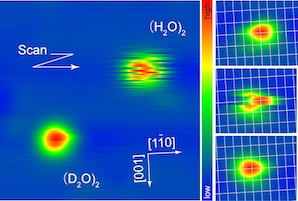 “Water Dimers”
“Water Dimers”[T. Kumagai, et. al. Phys. Rev. Lett. 100, 166101 (2008).]
STM image simultaneously acquired for H2O and D2O dimers (size: 5.5×5.5 nm^2, 2.4×2.0 nm^2). The dimer is characterized by the bi-stable fluctuating image. The dimer consists of hydrogen-bond donor and acceptor molecules. The fluctuating image results from the interchange of the donor and acceptor, in which the roles of their molecules are exchanged. Interestingly, the STM image of the dimer shows drastic change upon substitution with D2O. It suggests that the interchange process involves quantum tunneling. The image was obtained at 24 mV sample bias and 0.5 nA tunneling current at 6 K.
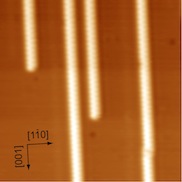 “Water One-Dimensional Chain”
“Water One-Dimensional Chain”
[T. Yamada et. al. Phys. Rev. Lett. 96, 036105 (2006).]
STM image of a water chain (size: 15.0×15.0 nm^2). Water molecules are self-assembled into one-dimensional chains on Cu(110) at 78 K. The image was obtained at 0.1 V sample bias and 0.2 nA tunneling current.
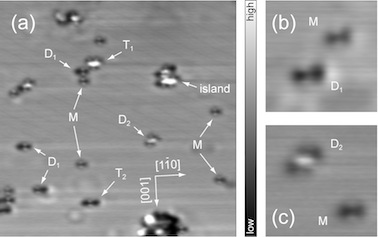 “Acetylene molecules on Cu(110)”
“Acetylene molecules on Cu(110)”
[T. Kumagai et. al. J. Chem. Phys. 126, 234708 (2007).]
Typical STM image of Cu(110) exposed to acetylene (C2H2) at 40 K. (a) A large-scale image (size: 28×28 nm2) showing isolated monomer (M), two types of dimer (D1, D2), timer (T1, T2), and larger islands. The image was obtained at -0.1 V sample bias and 0.5 nA tunneling current. (b) and (c) shows the two types dimer (2.95×2.95 nm^2). These images were obtained at -0.1V sample bias and 0.2 nA tunneling current.
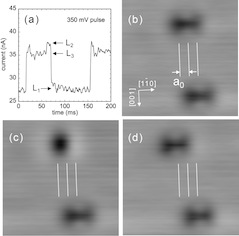 “Hopping of Acetylene”
“Hopping of Acetylene”
[T. Kumagai et. al. J. Chem. Phys. 126, 234708 (2007).]
Hopping motion of acetylene on Cu(110). By applying a high voltage pulse, the hopping motion of an acetylene molecule can be induced. An acetylene molecule hops to neighboring site via intermediate state as shown in (b)-(d). (a) Typical tunneling current recorded with the tip was fixed over the molecule during the voltage pulse. L1, L2, and L3 correspond to (b), (c), and (d).
 “Water Monomers”
“Water Monomers”
[T. Kumagai et. al., Hyoumen Kagaku (Surface Science) 29 No. 8, 484 (2008)]
Typical STM image of water monomers on Cu(110) (size: 4.3×4.3 nm^2). The monomer appears as a round protrusion. The fractional image of bottom center molecule indicates that it hops during the scanning across it. The image was obtained at 24 mV sample bias and 0.5 nA tunneling current.
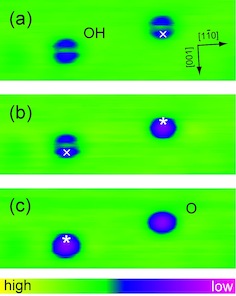 “Dissociation of Hydroxyl”
“Dissociation of Hydroxyl”
[T. Kumagai et. al., Hyoumen Kagaku (Surface Science) 29 No. 8, 484 (2008)]
STM images showing sequential dissociation of hydroxyl species (OH) into atomic oxygen. (a) OH appears paired depression aligned along [001] direction. Voltage pulse of a 0.9 V was applied over the one depression of OH (indicated the cross). (b) The image after the voltage pulse shows the change into a round depression which was identified as an atomic oxygen.
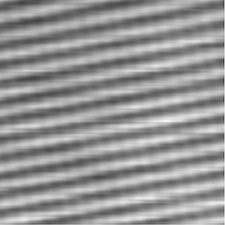 “Clean Surface of Cu(110)”
“Clean Surface of Cu(110)”
Cu(110) clean surface. The image was acquired by molecule modified tip. Cu(110) has anisotropic atomic geometry. There are atomic rows along the [10] direction. The image was obtained at 14 mV sample bias and 500 nA tunneling current.
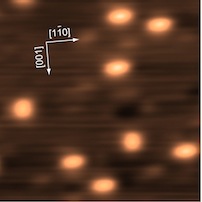 “Butadiene Molecules on Cu(110)”
“Butadiene Molecules on Cu(110)”
[T. Kumagai et. al. unpublished]
Typical STM image of butadiene on the Cu(110) surface (size: 10.0×10.0 nm^2). There are two different orientations. The image was obtained at 44 mV sample bias and 5 nA tunneling current.